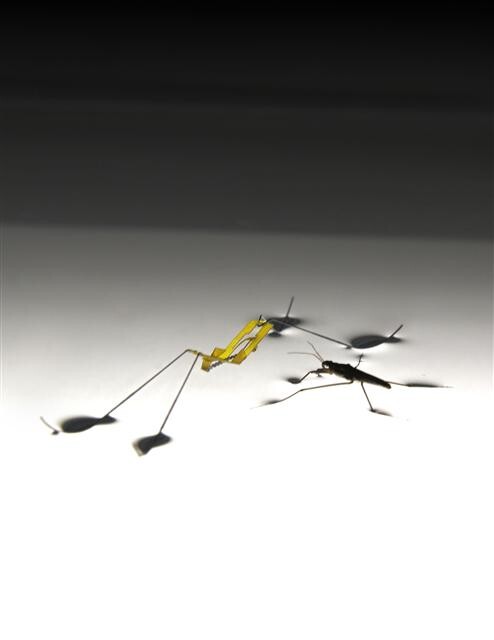hankyoreh
Links to other country sites 다른 나라 사이트 링크
“Water strider robot” developed by a S. Korean research team

South Korean researchers have developed a “water strider robot” that uses the same principles as the insect to leap on water using surface tension.
The research team of professors Kim Ho-young and Cho Kyu-jin from the Seoul National University department of mechanical and aerospace engineering announced on July 30 that it had “elucidated the hydrodynamics involved” when the water strider jumps on water using surface tension and “applied them to develop a bio-inspired impulsive mechanism,” or small robot. The team’s paper was published in the July 30 issue of the noted journal Science.
The water strider lives on the surface of water relying on surface tension. The research team learned that the principle that allows the water strider to leap without sinking has to do with not simply pushing the surface downward, but rotating the four outstretched legs toward the center.
“When animals jump on land, they apply a lot of force in a short time,” explained Cho. “But you can jump just as high if you apply a small force over a long period of time [like the water strider].”
“It’s the same principle as being able to send a fully inflated ball a long distance by kicking it short and hard, but when the ball is deflated you have to gather your strength slowly before you kick it to send it a long way,” he added.
The team developed its water strider robot by arranging shape memory alloy - a material that changes shape when heated but returns to its original shape - in a “pop-up book” style. The one-centimeter-high robot weighs 0.068 grams, or slightly more than a water strider, and used its four five-centimeter-long legs to jump as high as 14 cm above the water’s surface.
“It’s significant that we have determined the principle behind the water strider’s jump,” Cho said.
“Small robots like these could be scattered in disaster zones or contaminated areas or on the battlefield in large quantities to do monitoring and surveillance or find people,” he added.
By Lee Keun-young, senior staff writer
Please direct questions or comments to [english@hani.co.kr]

Editorial・opinion
![[Column] Park Geun-hye déjà vu in Yoon Suk-yeol [Column] Park Geun-hye déjà vu in Yoon Suk-yeol](https://flexible.img.hani.co.kr/flexible/normal/500/300/imgdb/original/2024/0424/651713945113788.jpg) [Column] Park Geun-hye déjà vu in Yoon Suk-yeol
[Column] Park Geun-hye déjà vu in Yoon Suk-yeol![[Editorial] New weight of N. Korea’s nuclear threats makes dialogue all the more urgent [Editorial] New weight of N. Korea’s nuclear threats makes dialogue all the more urgent](https://flexible.img.hani.co.kr/flexible/normal/500/300/imgdb/original/2024/0424/7317139454662664.jpg) [Editorial] New weight of N. Korea’s nuclear threats makes dialogue all the more urgent
[Editorial] New weight of N. Korea’s nuclear threats makes dialogue all the more urgent- [Guest essay] The real reason Korea’s new right wants to dub Rhee a founding father
- [Column] ‘Choson’: Is it time we start referring to N. Korea in its own terms?
- [Editorial] Japan’s rewriting of history with Korea has gone too far
- [Column] The president’s questionable capacity for dialogue
- [Column] Are chaebol firms just pizza pies for families to divvy up as they please?
- [Column] Has Korea, too, crossed the Rubicon on China?
- [Correspondent’s column] In Japan’s alliance with US, echoes of its past alliances with UK
- [Editorial] Does Yoon think the Korean public is wrong?
Most viewed articles
- 1[Column] Park Geun-hye déjà vu in Yoon Suk-yeol
- 2Will NewJeans end up collateral damage in internal feud at K-pop juggernaut Hybe?
- 3N. Korean hackers breached 10 defense contractors in South for months, police say
- 4[Editorial] New weight of N. Korea’s nuclear threats makes dialogue all the more urgent
- 5[Cine feature] A new shift in the Korean film investment and distribution market
- 6Up-and-coming Indonesian group StarBe spills what it learned during K-pop training in Seoul
- 7[Column] The clock is ticking for Korea’s first lady
- 8Terry Anderson, AP reporter who informed world of massacre in Gwangju, dies at 76
- 9Thursday to mark start of resignations by senior doctors amid standoff with government
- 10Kim Jong-un expressed ‘satisfaction’ with nuclear counterstrike drill directed at South